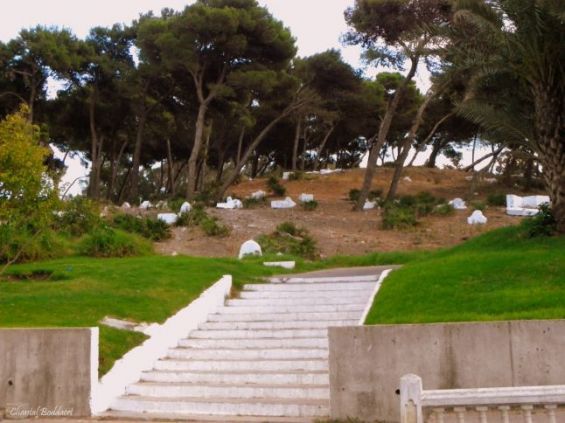Tangier is home to Africa’s first pet cemetery. The graveyard dubbed «The Animal Rest Home» served since the 40s as a resting place for faithful cats and dogs and for the city's working animals.
The cemetery has survived the heavy rains, neglect and other factors and is still up and running. However, for activists and NGOs in Tangier, the unique facility needs urgent assistance.
Mentioned in history books
The Boubana cemetery, however, has been a remarkable spot of the city for years. It has even made it to history books and memoirs. In an interview with American biographer Virginia Spencer, American writer and novelist Paul Bowles who lived in Tangier for years, referred to the city’s animal cemetery.
«Up along the road at the base of the mountain is 'The Animal Rest Home' which is worth a wander only to glance at the amusing headstones where Bowles once claimed to want to spend the afterlife», wrote Josh Shoemake in his book «Tangier : A Literary Guide for Travellers» (I.B. Tauris, 2013).
Indeed, the American expatriate had a very particular plan for his burial, which included the Boubana cemetery. «If I have to be buried in the ground, I would like it to be in the animal cemetery here in Tangier, along with the dogs and cats that belonged to the European residents», Bowles told Virginia Spencer.
 Tea with an architect./Ph. DR
Tea with an architect./Ph. DR
Tangier’s exceptional pet cemetery was briefly referred to by Susan Searight in her book «Maverick Guide to Morocco» (Pelican Publishing). «The dogs’ cemetery, unique to Tangier, is not here, but in the upper town ‘the mountain'», wrote Searight.
«Pet cats are also buried here, with their names engraved on the tombstones», added the same writer.
A nursing home for Tangier's working animals
Impressed by the graveyard, none of these writers knew who was behind the brilliant idea of dedicating a small spot of the town to deceased animals and pets. Only Abdou Benattabou from Tangier’s Zanka 90 association, knew the story of «The Animal Rest Home».
Speaking to Yabiladi on Monday, Benattabou recalled that the cemetery was part of a humane project initiated by a group of British expatriates in the 40s.
«In 1940, a British diplomat gathered all British nationals in Tangier to find a solution for working animals who suffered from maltreatment in the city», he explained.
According to Abdou Benattabou, every Sunday animals in Tangier were taken by their owners to the weekly market (souk) for the purchasing of goods. Every week, these working mules and donkeys had to carry heavy loads and merch on their backs, the thing that angered these expatriates.

«The British lady decided to purchase, with the help of other families, a land and build a nursing home for Tangier’s working animals», said the activist. The facility was a hospital where sick animals were housed, treated and buried after their death.
The cemetery, however, did not see light until the 50s, where famous interior decorator David Herbert decided to launch a very unique initiative. «He had the idea of creating a pet cemetery», said Bouattabou, insisting that the idea suited the lifestyle of the city’s inhabitants at the time.
«It was the start of the Hippy era and a lot of the city’s inhabitants had pets», he added. Since then cats, dogs, and many other animals were buried in Boubana by their masters.
Falling through the cracks
In a video shot by the association that defends Tangier’s authenticity, and cultural facilities, the cemetery’s situation was revealed. Its tombstones looked destroyed and neglected, a reality that was denounced by Abdou Bouattabou.
«The cemetery’s guard is taking advantage of the land and he herds his animals there which step on tombs and destroy them», he argued. «The heavy rains have also affected this old treasure», said the same source.
Bouattabou, alongside members of his association, want to preserve the cemetery but their attempts, unfortunately couldn’t fulfill the initiative.
«We discovered that the land is owned, currently, by a 90-year-old Jewish woman who has two hotels and is busy managing them. We have tried to reach her several times but we couldn’t», said the Tangier activist.
Contacting the land’s owner is primordial for the refurbishment of the cemetery which houses the oldest animal tombs in the city. «The oldest burial done in this cemetery dates back to 1943, it is impressive to know that this animals was buried before Morocco gained independence», he concluded.





 chargement...
chargement...













